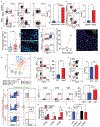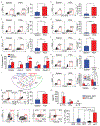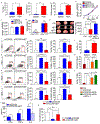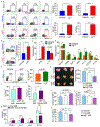Innate αβ T Cells Mediate Antitumor Immunity by Orchestrating Immunogenic Macrophage Programming
- PMID: 31266770
- PMCID: PMC6726581
- DOI: 10.1158/2159-8290.CD-19-0161
Innate αβ T Cells Mediate Antitumor Immunity by Orchestrating Immunogenic Macrophage Programming
Abstract
Unconventional T-lymphocyte populations are emerging as important regulators of tumor immunity. Despite this, the role of TCRαβ+CD4-CD8-NK1.1- innate αβ T cells (iαβT) in pancreatic ductal adenocarcinoma (PDA) has not been explored. We found that iαβTs represent ∼10% of T lymphocytes infiltrating PDA in mice and humans. Intratumoral iαβTs express a distinct T-cell receptor repertoire and profoundly immunogenic phenotype compared with their peripheral counterparts and conventional lymphocytes. iαβTs comprised ∼75% of the total intratumoral IL17+ cells. Moreover, iαβT-cell adoptive transfer is protective in both murine models of PDA and human organotypic systems. We show that iαβT cells induce a CCR5-dependent immunogenic macrophage reprogramming, thereby enabling marked CD4+ and CD8+ T-cell expansion/activation and tumor protection. Collectively, iαβTs govern fundamental intratumoral cross-talk between innate and adaptive immune populations and are attractive therapeutic targets. SIGNIFICANCE: We found that iαβTs are a profoundly activated T-cell subset in PDA that slow tumor growth in murine and human models of disease. iαβTs induce a CCR5-dependent immunogenic tumor-associated macrophage program, T-cell activation and expansion, and should be considered as novel targets for immunotherapy.See related commentary by Banerjee et al., p. 1164.This article is highlighted in the In This Issue feature, p. 1143.
©2019 American Association for Cancer Research.
Conflict of interest statement
The authors declare no competing interests.
Figures






Comment in
-
Unconventional T Cells in the Pancreatic Tumor Microenvironment: Thinking Outside the Box.Cancer Discov. 2019 Sep;9(9):1164-1166. doi: 10.1158/2159-8290.CD-19-0722. Cancer Discov. 2019. PMID: 31481406
References
Publication types
MeSH terms
Substances
Grants and funding
LinkOut - more resources
Full Text Sources
Medical
Molecular Biology Databases
Research Materials

